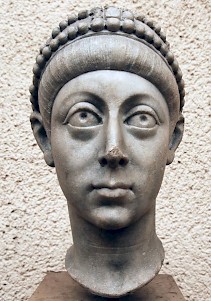Synesius, On Providence

The Egyptian Tale, or, On Providence, is one part of his diptych on good kingship. (The other part is On Imperial Rule.) Although The Egyptian Tale looks like a retelling of a part of the myth of Isis and Osiris, it is obvious that the two brothers Osiris and Typho represent good and bad government.
Roman à clef
The story, however, is not just a myth, because the man called Osiris can be identified as Aurelian, praetorian prefect of the Eastern Empire during the reign of Arcadius. (In 1.3 and 2.4, Osiris' career is outlined, and it closely matches Aurelian's.) He was one of Synesius' benefactors. The other persons in this ancient roman à clef, however, are less easy to identify.
Typho
Typho, the brother of Osiris, cannot be identified, although he obviously took power when Aurelian was sent into exile after a Germanic leader named Gainas had taken over power.note We cannot identify Gainas' partner in Constantinople, who became military leader himself: Caesarius and Eutychianus have been mentioned, but they are not known to have been brothers. But perhaps, Aurelian's opponent was not really his brother, and perhaps he was not a Roman at all. Allowing for some artificial license - perhaps Gainas himself is the man behind Typho.
Scythians
Synesius' code name for Germanic warriors who had settled in the Roman Empire. Many of had them lived north of the Danube, in the country that had once been the land of the Scythians, to the name is apt.
Commander
If Typho is Caesarius or Eutychianus, the commander of the Scythians is Gainas.
Thebes
Synesius' name for Constantinople.
Egypt
Synesius' code name for the Roman Empire.
River
In Synesius' story, the Nile is meant, but in reality, it is the Bosphorus.
Summary
- Prologue: A work in two parts
- 1.1: Introduction of the two protagonists, Osiris and Typho
- 1.2: Youth of the pious Osiris and evil Typho
- 1.3-4: Their careers; death of their father
- 1.5-6: Procedure of electing a king
- 1.7: Osiris elected
- 1.8: Advice from the courtiers
- 1.9-11: Speech from his deified father: how to be a good king
- 1.12: Blessed reign of the virtuous Osiris
- 1.13: Typho’s wife
- 1.14: Typho’s illness
- 1.15: Typho’s wife creates a coalition with the Scythian mercenaries, who capture Thebes
- 1.16: Osiris leaves the city; Typho’s reign of terror
- 1.17: General corruption of Egyptian morals
- 1.18: A man from the country denounces Typho
- 2.1: The gods intervene; the Scythian mercenaries feel uneasy in the city and decide to build their camp elsewhere
- 2.2: An incident at one of the gates leads to an insurrection
- 2.3: A Council decides to dethrone Typho
- 2.4: Triumphal return of Osiris; he pardons his brother
- 2.5-8: Some reflections by Synesius
The text is offered here in the translation by A. Fitzgerald. The green four-digit numbers are page numbers of the Migne edition.